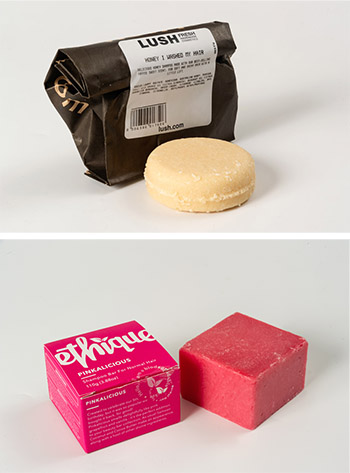
Shampoo bars
Should you bin the bottle in favour of a shampoo bar?
With plastic choking our oceans, every day’s a bad hair day for the planet. Switching to a shampoo bar will help reduce the rubbish, but how will your tresses fare?
Our test
We gave 10 Consumer volunteers a bar of either Lush’s Honey I Washed My Hair ($17.50) or Ethique’s Pinkalicious ($22) to try for a few weeks. The reviews were overwhelmingly positive, with eight users keen to make the switch official.

Reducing waste was a key driver in their decision (shampoo bars come wrapped in paper or packaged in cardboard boxes), but most were also delighted with the condition of their hair.
“My hair felt lovely. My partner likes it too. We have very different hair so it was nice to find something that works for both of us.”
One of the unhappy trialists said her scalp had started to itch and her hair felt dry and stringy. She wasn’t giving up on shampoo bars, though, and hoped “a different formula would be better”.
Many users remarked how convenient the compact size was for travelling, but the biggest drawback was that once the packaging had been removed, the bar looked confusingly like regular soap. Also, without a container, it got wet and “mushy”.
How many washes do you get?
Some manufacturers, including Lush and Ethique, claim one bar can provide as many washes as three bottles of liquid shampoo.
By our calculations, if an average user gets 25 washes from a 250ml bottle, a bar should last at least 75. Statements like that turn heads at Consumer, so we started scrubbing – and got at least 80 washes (medium-length hair) from each bar.
That makes a pretty good argument for switching because not only could using a bar prevent three plastic bottles from ending up at the tip, it might also save you money, especially if you normally use a salon-only shampoo costing upwards of $30.
Tip: Shampoo bars are simple to use: just wet the bar, swipe it over wet hair three or four times, lather, then rinse.
Concerned about chemicals?
Another reason to hit the bar? Potentially fewer harmful chemicals.
Water (aqua) is the main ingredient in liquid shampoo, so preservatives are added to prolong shelf-life and stop water-loving microbes from spoiling the product. Solid shampoos needn’t contain much water and therefore need few, if any, preservatives.
Even if a shampoo bar is preservative-free, it could still contain allergens.
Allergic reactions and sensitisation are common issues with preservatives: a review by the European Commission’s Scientific Committee on Consumer Safety found sensitisation to the preservative methylisothiazolinone (MI) to be an “increasing problem”. MI is present in some shampoos sold in New Zealand.
Even if a shampoo bar is preservative-free, it could still contain allergens. Some people react to common fragrances used in cosmetics – one of the reasons products must have an ingredients list.
Soap bar vs. shampoo bar
Shampoo bars look like soap – but if you’ve ever tried washing your hair with soap, or your body with shampoo, you’ll know they’re not exactly interchangeable. Soap is made with lye (sodium hydroxide) and is alkaline (often with a pH of 9 or 10), whereas shampoo is generally acidic (lower than 7), so before you shell out for a shampoo bar, check the ingredients list to make sure you’re not buying soap.
What’s in them?
The main ingredients in shampoo bars are surfactants, oils and fragrances. Surfactants help with the cleaning part, oils and fragrances make the product smell nice, and thickeners and emulsifiers bind it all together.
Lush – Honey I Washed My Hair

Sodium laurel sulfate [surfactant], honey, perfume, sweet wild orange oil, bergamot oil, water, limonene (citrus peel), linalool [fragrance], amyl cinnamal [fragrance], citronellol [fragrance], butylphenyl methylpropional [fragrance].
Ethique – Pinkalicious
Sodium cocoyl isethionate [surfactant], decyl glucoside [surfactant], sodium coco-sulfate [surfactant], Cocos nucifera (coconut) butter [emollient, thickener], stearic acid [thickener], cocoa butter, caprylic/capric triglyceride [emollient], cetyl alcohol [emollient, thickener], stearyl alcohol [emulsifier], behentrimonium methosulphate [emulsifier], pink grapefruit peel oil, vanilla oil, lactic acid [pH regulator], red mica [pigment], citral [fragrance], limonene [fragrance], linalool [fragrance].
Member comments
Get access to comment